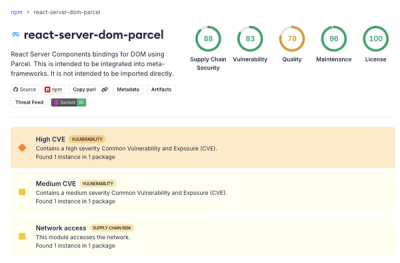
Security News
Deno 2.6 + Socket: Supply Chain Defense In Your CLI
Deno 2.6 introduces deno audit with a new --socket flag that plugs directly into Socket to bring supply chain security checks into the Deno CLI.
flask-request-id-header
Advanced tools
Python Flask middleware to ensure all requests have a request ID header.
This middleware ensures all request made to a Flask application includes a Request ID header (X-Request-ID),
containing at least one unique value.
Request IDs or Correlation IDs can be used when logging errors and allows users to trace requests through multiple layers such as load balancers and reverse proxies. The request ID header value may consist of multiple IDs encoded according to RFC 2616.
This package can be installed using Pip from PyPi:
$ pip install flask-request-id-header
This middleware has no required parameters and by default will add a request header to requests where one does not already exist, or append a unique value where existing request IDs do not contain at least one UUID (version 4) value.
A minimal application would look like this:
from flask import Flask
from flask_request_id_header.middleware import RequestID
app = Flask(__name__)
RequestID(app)
@app.route('/')
def hello_world():
return 'hello world'
Optionally a Flask config option, REQUEST_ID_UNIQUE_VALUE_PREFIX, can be set whereby any request ID beginning with
this prefix be treated as unique, preventing an additional value being appended.
A minimal application would look like this:
from flask import Flask
from flask_request_id_header.middleware import RequestID
app = Flask(__name__)
app.config['REQUEST_ID_UNIQUE_VALUE_PREFIX'] = 'FOO-'
RequestID(app)
@app.route('/')
def hello_world():
return 'hello world'
The current request ID can be accessed wherever a request context exists:
from flask import request, has_request_context
if has_request_context():
print(request.environ.get("HTTP_X_REQUEST_ID"))
To access the request ID outside of the current application, it is included in the response (as X-Request-ID).
Note: Components between the application and the client, such as reverse proxies, may alter or remove this header value before reaching the client.
Optionally, the current request ID can be included in application logs, where a request context exists.
A minimal application would look like this:
import logging
from flask import Flask, request, has_request_context
from flask.logging import default_handler
from flask_request_id_header.middleware import RequestID
app = Flask(__name__)
app.config['REQUEST_ID_UNIQUE_VALUE_PREFIX'] = 'FOO-'
RequestID(app)
class RequestFormatter(logging.Formatter):
def format(self, record):
record.request_id = 'NA'
if has_request_context():
record.request_id = request.environ.get("HTTP_X_REQUEST_ID")
return super().format(record)
formatter = RequestFormatter(
'[%(asctime)s] [%(levelname)s] [%(request_id)s] %(module)s: %(message)s'
)
default_handler.setFormatter(formatter)
@app.route('/')
def hello_world():
return 'hello world'
A docker container ran through Docker Compose is used as a development environment for this project defined . It
includes development only dependencies listed in requirements.txt, a local Flask application in app.py and
Integration tests.
Ensure classes and methods are defined within the flask_request_id_header package.
Ensure Integration tests are written for any new feature, or changes to existing features.
If you have access to the BAS GitLab instance, pull the Docker image from the BAS Docker Registry:
$ docker login docker-registry.data.bas.ac.uk
$ docker-compose pull
# To run the local Flask application using the Flask development server
$ docker-compose up
# To start a shell
$ docker-compose run app ash
PEP-8 style and formatting guidelines must be used for this project, with the exception of the 80 character line limit.
Flake8 is used to ensure compliance, and is ran on each commit through Continuous Integration.
To check compliance locally:
$ docker-compose run app flake8 . --ignore=E501
Development Python dependencies should be declared in requirements.txt to be included in the development environment.
Runtime Python dependencies should be declared in requirements.txt and setup.py to also be installed as dependencies
of this package in other applications.
All dependencies should be periodically reviewed and update as new versions are released.
$ docker-compose run app ash
$ pip install [dependency]==
# this will display a list of available versions, add the latest to `requirements.txt` and or `setup.py`
$ exit
$ docker-compose down
$ docker-compose build
If you have access to the BAS GitLab instance, push the Docker image to the BAS Docker Registry:
$ docker login docker-registry.data.bas.ac.uk
$ docker-compose push
To ensure the security of this API, all dependencies are checked against Snyk for vulnerabilities.
Warning: Snyk relies on known vulnerabilities and can't check for issues that are not in it's database. As with all security tools, Snyk is an aid for spotting common mistakes, not a guarantee of secure code.
Some vulnerabilities have been ignored in this project, see .snyk for definitions and the
Dependency exceptions section for more information.
Through Continuous Integration, on each commit current dependencies are tested and a snapshot uploaded to Snyk. This snapshot is then monitored for vulnerabilities.
This project contains known vulnerabilities that have been ignored for a specific reason.
yaml.load() function allows Arbitrary Code Execution
bandit packageTo ensure the security of this API, source code is checked against Bandit for issues such as not sanitising user inputs or using weak cryptography.
Warning: Bandit is a static analysis tool and can't check for issues that are only be detectable when running the application. As with all security tools, Bandit is an aid for spotting common mistakes, not a guarantee of secure code.
Through Continuous Integration, each commit is tested.
To check locally:
$ docker-compose run app bandit -r .
This project uses integration tests to ensure features work as expected and to guard against regressions and vulnerabilities.
The Python UnitTest library is used for running tests using Flask's
test framework. Test cases are defined in files within tests/ and are automatically loaded when using the
test Flask CLI command included in the local Flask application in the development environment.
Tests are automatically ran on each commit through Continuous Integration.
To run tests manually:
$ docker-compose run -e FLASK_ENV=testing app flask test
To run tests using PyCharm:
In Configuration tab:
[absolute path to project]/tests[absolute path to project][absolute path to project]=/usr/src/appNote: This configuration can be also be used to debug tests (by choosing debug instead of run).
All commits will trigger a Continuous Integration process using GitLab's CI/CD platform, configured in .gitlab-ci.yml.
This process will run the application Integration tests.
Pip dependencies are also checked and monitored for vulnerabilities.
Both source and binary versions of the package are build using SetupTools, which
can then be published to the Python package index for use in other
applications. Package settings are defined in setup.py.
This project is built and published to PyPi automatically through Continuous Deployment.
To build the source and binary artefacts for this project manually:
$ docker-compose run app ash
# build package to /build, /dist and /flask_reverse_proxy_fix.egg-info
$ python setup.py sdist bdist_wheel
$ exit
$ docker-compose down
To publish built artefacts for this project manually to PyPi testing:
$ docker-compose run app ash
$ python -m twine upload --repository-url https://test.pypi.org/legacy/ dist/*
# project then available at: https://test.pypi.org/project/flask-request-id-header/
$ exit
$ docker-compose down
To publish manually to PyPi:
$ docker-compose run app ash
$ python -m twine upload --repository-url https://pypi.org/legacy/ dist/*
# project then available at: https://pypi.org/project/flask-request-id-header/
$ exit
$ docker-compose down
A Continuous Deployment process using GitLab's CI/CD platform is configured in .gitlab-ci.yml. This will:
This process will deploy changes to PyPi testing on all commits to the master branch.
This process will deploy changes to PyPi on all tagged commits.
release branch.dev{ os.getenv('CI_PIPELINE_ID') or None } from the version parameter in setup.py and ensure version
is bumped as per semverCHANGELOG.mdrelease branch into master and tag with versionThe project will be built and published to PyPi automatically through Continuous Deployment.
next-release branchsetup.py and append .dev{ os.getenv('CI_PIPELINE_ID') or None } to signify anext-release branch into masterThe maintainer of this project is the BAS Web & Applications Team, they can be contacted at: servicedesk@bas.ac.uk.
This project uses issue tracking, see the Issue tracker for more information.
Note: Read & write access to this issue tracker is restricted. Contact the project maintainer to request access.
© UK Research and Innovation (UKRI), 2019, British Antarctic Survey.
You may use and re-use this software and associated documentation files free of charge in any format or medium, under the terms of the Open Government Licence v3.0.
You may obtain a copy of the Open Government Licence at http://www.nationalarchives.gov.uk/doc/open-government-licence/
FAQs
Python Flask middleware to ensure all requests have a request ID header
We found that flask-request-id-header demonstrated a healthy version release cadence and project activity because the last version was released less than a year ago. It has 1 open source maintainer collaborating on the project.
Did you know?

Socket for GitHub automatically highlights issues in each pull request and monitors the health of all your open source dependencies. Discover the contents of your packages and block harmful activity before you install or update your dependencies.

Security News
Deno 2.6 introduces deno audit with a new --socket flag that plugs directly into Socket to bring supply chain security checks into the Deno CLI.

Security News
New DoS and source code exposure bugs in React Server Components and Next.js: what’s affected and how to update safely.

Security News
Socket CEO Feross Aboukhadijeh joins Software Engineering Daily to discuss modern software supply chain attacks and rising AI-driven security risks.